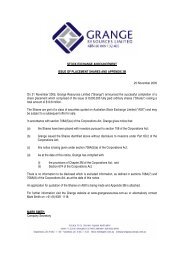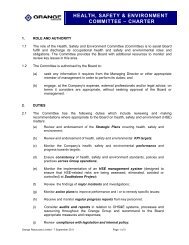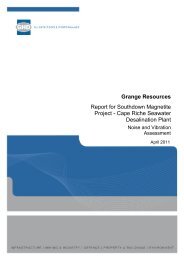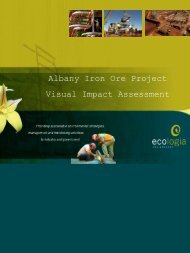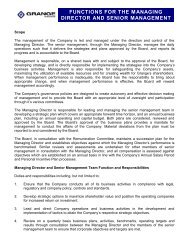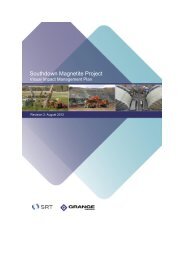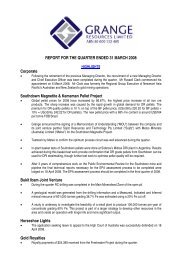2012 Annual Report (2 April 2013) - Grange Resources
2012 Annual Report (2 April 2013) - Grange Resources
2012 Annual Report (2 April 2013) - Grange Resources
Create successful ePaper yourself
Turn your PDF publications into a flip-book with our unique Google optimized e-Paper software.
<strong>2012</strong> ANNUAL REPORT<br />
61<br />
PAGE<br />
(a) Market Risk<br />
(i) Foreign exchange risk<br />
The Group operates internationally and is exposed to foreign<br />
exchange risk arising from various currency exposures, primarily<br />
with respect to the US dollar.<br />
Foreign exchange risk arises from commercial transactions,<br />
given that the Group’s sales revenues are denominated in US<br />
dollars and the majority of its operating costs are denominated<br />
in Australian dollars, and recognised assets and liabilities<br />
denominated in a currency that is not the entity’s functional<br />
currency. The risk is measured using sensitivity analysis and cash<br />
flow forecasting.<br />
At this time the Group does not manage its prospective foreign<br />
exchange risk with currency hedges.<br />
The Group’s exposure to US dollar denominated foreign currency<br />
risk at the reporting date, expressed in Australian dollars, was as<br />
follows:<br />
<strong>2012</strong> 2011<br />
$’000 $’000<br />
Cash and cash equivalents 90,198 54,984<br />
Term deposits - 16,738<br />
Trade and other receivables 13,519 37,694<br />
Trade and other payables (916) (874)<br />
Borrowings (13,876) (25,620)<br />
Deferred consideration (49,586) (65,352)<br />
Net US dollar surplus 39,339 17,570<br />
(ii) Group sensitivity<br />
Based on the financial instruments held at 31 December <strong>2012</strong>,<br />
had the Australian dollar weakened/strengthened by 10%<br />
against the US dollar with all other variables held constant,<br />
the Group’s post tax profit for the financial period would have<br />
been $4.1 million higher/$1.7 million lower (2011: $1.4 million<br />
higher/$1.1 million lower), mainly as a result of foreign exchange<br />
gains/losses on translation of US dollar denominated borrowings<br />
and deferred consideration off-set by US dollar denominated cash<br />
and cash equivalents and receivables as detailed in the above<br />
table.<br />
(iii) Price risk<br />
The Group is exposed to commodity price risk. During prior years,<br />
the Group agreed with its customers to price its iron ore pellets<br />
at index based market prices. At this time, the Group does not<br />
manage its iron ore price risk with financial instruments.<br />
Going forward, the Group may consider using financial<br />
instruments to manage commodity price risk given exposures to<br />
market prices arising from the adoption of index based market<br />
pricing mechanisms.<br />
(iv) Cash flow and fair value interest rate risk<br />
The Group’s main interest rate risk arises from long term<br />
borrowings. Borrowings are issued at variable rates exposing<br />
the Group to cash flow interest rate risk. Borrowings issued at<br />
fixed rates expose the Group to fair value interest rate risk if the<br />
borrowings are carried at fair value.<br />
As at the reporting date, the Group has the following variable rate<br />
borrowings outstanding:<br />
<strong>2012</strong> 2011<br />
Weighted<br />
Weighted<br />
average<br />
average<br />
interest<br />
interest<br />
rate Balance rate Balance<br />
% $’000 % $’000<br />
Borrowings 2.08 9,054 4.76 19,128<br />
The Group’s fixed rate borrowings are carried at amortised<br />
cost. As they are fixed rate borrowings, they are not subject to<br />
interest rate risk as defined by AASB 7, Financial Instruments:<br />
Disclosures.<br />
The Group analyses its interest rate exposure on a dynamic<br />
basis. Various scenarios are simulated taking into consideration<br />
refinancing, renewal of existing positions, alternative financing<br />
and hedging. Based on these scenarios, the Group calculates<br />
the impact on profit and loss of a defined interest rate shift. No<br />
financial instruments are used to manage interest rate risk.<br />
Group sensitivity<br />
The Group’s fixed rate borrowings are carried at amortised cost.<br />
As they are fixed rate borrowing, they are not subject to interest<br />
rate risk and are excluded from the interest rate sensitivity<br />
analysis.<br />
At 31 December <strong>2012</strong>, if interest rates had increased by 50 basis<br />
points (bps) or decreased by 50 basis points from the period<br />
end rates with all other variables held constant, post tax profit<br />
for the period would have been $0.6 million higher/$0.6 million<br />
lower (December 2011 changes of 50bps/50 bps: $0.8 million<br />
higher/$0.8 million lower).<br />
(b) Credit Risk<br />
Credit risk is managed on a Group basis. Credit risk arises from<br />
cash and cash equivalents and deposits with banks and financial<br />
institutions, as well as credit exposures to customers, including<br />
outstanding receivables and committed transactions.<br />
The Group is exposed to a concentration of risk with sales of iron<br />
ore being made to a limited number of customers. The maximum<br />
exposure to credit risk at the reporting date is limited to the<br />
carrying value of trade receivables, cash and cash equivalents<br />
and deposits with banks and financial institutions.<br />
The Group has no receivables past due as at 31 December <strong>2012</strong>.



